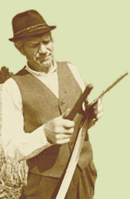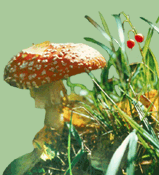Tree of the Year: Hazel Tree
Ivar Sibul gives an overview of the relatives of the hazel tree, its reproduction characteristics and nuts and other interesting aspects. The Common Hazel is spread quite extensively throughout Europe. It prefers fertile soils rich in humus and lime. It is a common inhabitant of alvars as well. The nuts are ripe by the middle of September, when the concentration of oils is the highest (5572% of the weight). Nowadays most nuts are picked from hazel plantations, with Turkey contributing 70% of the worlds hazelnut production. The Common Hazel and its varieties as well as its related species are also used in greenery.
Clever ant nest
Marten Laur introduces the surprising connections between the orientation skills of ants and the functioning principles of information systems. The article considers the behaviour of ant foraging and finding way home. It appears that network junctions have geometric polarity which help the ants to navigate in their search for their home nest. It is much like a digital system. Ants also use pheromones to mark foraging networks.
Musk-ox, the boss of the arctic tundras
Timo Palo describes an animal, whose hair is like a long skirt, horns are crooked like swords, but whose sight is clear and behaviour is dignified. Nowadays this majestic animal is found in North-East Canada, Canadian Arctic Archipelago and in the eastern part of Greenland. They number to about 60 000 individuals. The article gives a good overview of the biology and habits of the large Arctic mammal, accompanied with expressive photos of the animal.
Estonian Nature enquires
Tõnu Viik writes about the activities of 2008 for the Estonian Naturalists Society.
Herki Tuus introduces the news related to hobby fishing.
The two members of the Podiceps genus
Eda Muts introduces the everyday life of the Great Crested Grebe and the Horned Grebe, as fears and mating rituals go and in hand. The portrayal story presents numerous characteristic photographs of the two species and a brief overview of their behaviour and biology.
The last old-growth forest of the European broadleaved forest zone needs help
Tomasz Wesoùowski is worried about the fate of the Biaùowieýa old-growth forest, since only a tiny part of the former primeval forest is under protection the rest of it is desired by forest industries. The forest occupies 1600 km2, while only 105 km2 is under nature protection (National Park). Only 20% of the forest can still be classified as old-growth habitats. Every year 110 000150 000 cubic meters of timber is removed from the forest, as large-sized trunks are very highly appreciated goods. During the past decades, scientists and nature protectors have worked on stopping the intensive felling and trying to extend the boundaries of the national park. As they have no met much success, they plead all people to speak for the sake of the forest.
A cold-resistant stranger from the South
Mati Martin examines a unique species of dragon-fly, the Siberian Winter Damsel, whose imagos can be seen in early spring, late autumn and even in wintertime. This dragonfly is spread from Siberia to Far-East and is therefore well accustomed to cold conditions.
Feedback. Kaljo Simoson: Will the mystery of the Tungus explosion remain a mystery? 8/2008
Interview: The delicate relation with nature makes us vulnerable
Toomas Kukk has interviewed Ivar Puura, a geologist and nature protector.
Hiking trail: The primevally pretty Salevere Salumägi
Marju Pajumets takes the reader to the Matsalu National Park, to the bioherm mound with unusual geological past and unique biological present. The 1.5 km-long hiking trail gives a good overview of the development, nature and history of the area. The hill called Salemägi emerged in the Silurian era and represents a remnant mound made of bioherms. There are also signs of fortifications along the edge of the hill; while most of the hill has been used a field.
The upside-down domestic landscapes
Tapio Vares shares his expressions of the Cres Island in Croatia, which is a bit like a strongly amplified copy of West-Estonia. The author was fascinated with the olive groves and endless alvars of the North-Croatian islands and gives an inspiring overview of the diverse nature in the area.
The names and terms of living nature should be treated carefully
Ivar Veldre discusses the book European fish and elaborates on the use of Estonian biology language in general. He specifies the fish names in the book and proposes correct species names for numerous fish described in the book. The use of numerous other terms is questioned as well and alternatives are proposed.
The details of the Pilistvere meteorite fall
Kaljo Simson recalls his former searches for meteorite craters around Pilistvere and writes about a less-known matter: in 1980ies he managed to find a depression in the ground that could have been the explosion crater of the meteorite, with a single rock in the bottom. However, when he returned to make some further research, the depression was gone piled with quarry stones from the surrounding areas.
|


![[IN ENGLISH]](images/gb.gif)






